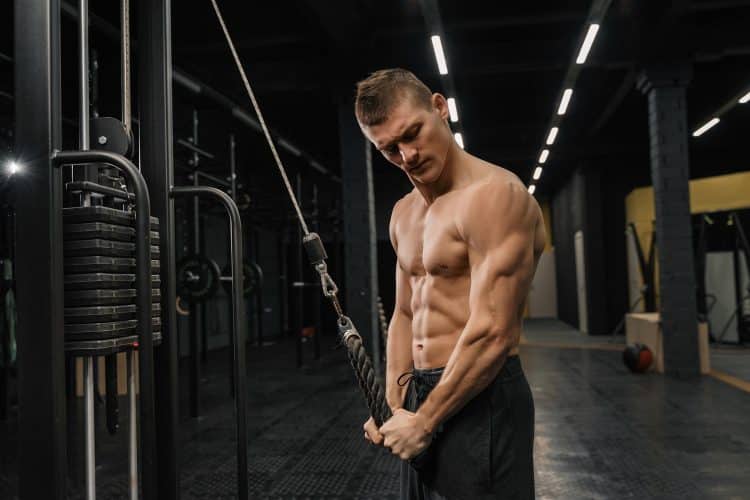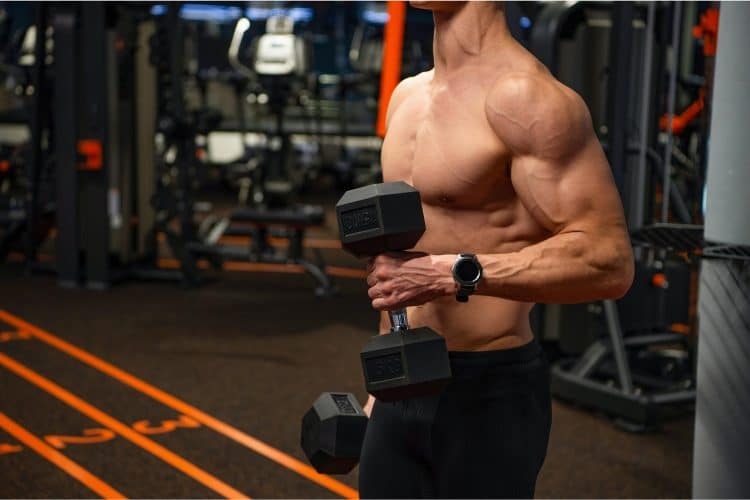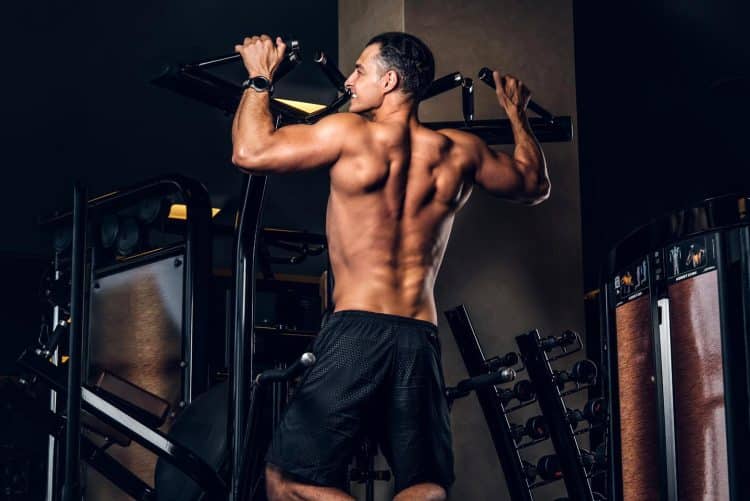There are several ways to program a training session. Most of these methods were engineered by bodybuilding pioneers in the 1940s and 50s to boost their workout efficiency. The superset advanced training technique was one of the most effective methods of this era. A superset involves performing two exercises back to back without stopping for rest between them.
Supersets are just as effective today as they were when they were first created, but only if you do them correctly.
In this article, we do a deep dive into supersets as a method to create more time-efficient and effective workouts. We’ll explore the science behind supersets, investigate the different types of supersets, explain how to design superset workouts and provide an overview of the common mistakes to avoid when doing supersets.
Read on for the definitive guide to supersets.
What is a Superset?
A superset is when you perform two exercises back to back. This differs from a traditional set where you do a set, rest for between a few seconds and several minutes, and then do the same exercise again. With supersets, the only rest is the time it takes to move from one exercise to the next.
In a superset workout, you rest after you have done the two exercises back to back. That rest period may be the same length as if you were doing traditional sets, or it may be slightly longer, depending on your training goals. You then repeat the superset for the prescribed number of total sets.

There are three types of supersets:
- Same muscle group supersets
- Unrelated muscle groups supersets
- Antagonistic or opposing muscle groups supersets
Supersets for the same muscle group are also known as compound sets. They are a great way to increase the intensity of the target muscle. Because you have pre-exhausted the muscle on the first exercise, the second exercise will be a lot harder. An example of a superset for the chest is to do the barbell bench press followed by dumbbell flyes.
You could also reverse that order, doing the flies first and then going to the bench press. This would be an example of pre-exhaustion training, where you purposefully fatigue the target muscle (your chest) before starting the second exercise.
Because your target muscle is fatigued in the second exercise, you will usually have to reduce the weight used on the second exercise in a compound superset. The rest period is usually longer than a standard set to allow for enough recovery to perform the next superset.
An example of a superset for unrelated muscle groups includes pairing side lateral raises for the shoulders with seated calf raises for the calves. This type of superset is mainly done to save time.
The opposing muscle groups are:
- Biceps and triceps
- Quadriceps and hamstrings
- Chest and back
- Deltoids and rotator cuffs
- Hip flexors and glutes
Science Behind Supersets
There has been limited research into the benefits of supersets compared with traditional sets. One study compared the energy cost of supersets and standard sets during and after workouts. The ten study participants performed four sets of six exercises for ten reps. One week the exercises were performed in a superset style, and the following week in a traditional set format.

The researchers reported that the superset training style produced significantly greater calorie burn during the workout and increased blood lactate and excess post-oxygen energy consumption (EPOC). The superset workouts were also considerably more time efficient than the traditional set workouts, completed in an average of 31 minutes, compared with 40 minutes for the conventional workouts. [1]
A meta-study published in the International Journal of Environmental Research and Public Health in 2019 concluded that supersets are an effective time-efficient solution to increase metabolic stress, which is a key contributor to muscle gains. [2]
A 2017 study published in the International Journal of Exercise Science showed that supersets require muscles to work more intensely than traditional sets. According to the study, the overall workload was 8% greater when doing the same exercises in a superset style rather than as traditional sets. [3]
Benefits of Supersets
They’re called supersets for a reason; they increase the efficiency of your workout. Here are four ways that adding supersets to your training can make your gym time more effective:
Supersets are More Time Efficient
The first and most obvious benefit of using supersets is that it will save you time. If you go directly from one exercise to another and then take a 90-second rest, you will save a minute and a half for every set you complete compared to if you had done the two exercises in the traditional set format.
Of course, saving time isn’t going to benefit you if work productivity is reduced. Some people may worry that fatigue on the first exercise may lead to reduced muscle activation on the second. However, a 2010 study published in the Journal of Strength & Conditioning Research compared supersets with traditional sets on the bench press and bench pull exercises. The researchers found no difference in volume load between the two protocols. EMG muscle stimulation was also no different in the target muscles (pectoralis major, anterior deltoid, latissimus dorsi, and trapezius muscles).
The researchers concluded that superset “training would appear to be an effective method of exercise with respect to VL maintenance and efficiency.” [4]
Supersets Give You a Great Pump
When you do supersets for antagonistic muscle groups, such as the biceps and triceps, you will experience enhanced muscle pumps. The stress on the muscles will cause blood to rush to those areas to bring oxygen and nutrients. This engorges the area with liquid volume, blowing the muscle up as if you were pumping a balloon. When this occurs on both sides of the limb simultaneously, it feels awesome.
To experience the enhanced pump effect of supersetting, try pairing cable dumbbell curls with tricep press downs or leg extensions for the quads with leg curls for the hamstrings.
Supersets Can Increase Workout Intensity
Pairing two exercises for the same muscle group will make the second exercise more challenging. This is especially the case when you do what we call pre-exhaustion superset training, which involves doing an isolation exercise and then jumping directly to a compound exercise for the same body part.
An example of a pre-exhaustion superset would be doing a dozen reps of dumbbell flyes and then going directly to the barbell bench press. This pre-exhausts the pectorals, making them take the focus of the effort and de-emphasizing the smaller anterior deltoid and triceps muscles, which usually are weaker.
If you try this type of superset, you’ll be amazed at the burn you’ll get in the target muscle group on the second exercise. You won’t be able to lift as much weight on that exercise, but the muscle activation will be much higher.
In a 2019 study, the strength and muscle hypertrophy effects of superset versus traditional sets of the leg press and leg extension were compared. The results showed significantly better strength and muscle improvement in the superset group. [5]

Supersets Can Reduce Muscle Imbalances
Performing antagonistic supersets will help create balanced muscle and strength development around a joint. Balanced development will help reduce your risk of injury. It will also improve your posture, coordination, and balance.
Downsides of Supersets
We’ve established that adding supersets to your workouts can make your training more efficient. However, when you turn up at your gym and try to implement it, it can be a different story entirely. Here are three potential drawbacks of superset training.
Supersets May Require Two Exercise Stations
Trying to use two exercise stations simultaneously in a commercial gym can be a challenge. Try doing it during peak hours, and it’s virtually impossible. Imagine going back and forth between the leg press and the leg extension at 6 pm on Monday. You won’t have a show!
If you’re going to throw some supersets into your program and the gym’s busy, your best bet is to stick with exercises you can do with the same piece of equipment. For example, you could set yourself up on a cable pulley machine and superset cable curls with tricep pulldowns, simply adjusting the height of the pulley between each exercise.
Supersets May Cause Form Breakdown
Supersetting is an advanced training technique. If you’re a beginner, it’s possible that your technique may be compromised on the second exercise due to fatigue. At best, that will result in compromised target muscle activation — at worst, it could result in a serious injury.
As a result, we don’t recommend introducing supersets until you’ve got at least a year’s training experience under your belt.
Supersets Can Impede Strength Gains
If your primary goal is to get stronger, supersets are probably not the way to go. On the first superset, you will be slightly weaker on the second exercise due to fatigue. Then with every succeeding set, you won’t be able to lift as much weight as if you were doing traditional sets with longer rest periods.
Use supersets as an intensity enhancer to build muscle and improve time efficiency. But when it comes to strength gains, traditional sets are best.
How to Get the Most Benefit from Supersets
Like any training tool, supersets are only as good as their application. Here are half a dozen ways to optimize your use of supersets:
Choose the right exercises and body parts
You can, theoretically, superset any exercises and body parts. But that doesn’t mean that you should. You need to choose your exercises carefully to meet your training goals.
For instance, if you’re going to do two exercises for the same body part, make sure you adjust accordingly. You will probably have to reduce the weight on the second exercise compared with what you would normally use. If you use the same weight, you’ll probably fall short of your target rep count.
You will also have to choose exercises that fit in with the type of training split you’re using. So, if you work your chest, triceps, and abs, you’ll have to stick with exercises that work those body parts. If you don’t, you’ll end up throwing your whole schedule out of whack.
You should also avoid pairing exercises that will compromise one another. For example, you wouldn’t want to pair wrist curls with pull-ups as the curls would fatigue your forearms, making it hard to grab onto the pull-up bar.
Get enough rest between supersets
After doing two sets back to back, you will be naturally more tired than if you just did one exercise. As a result, you may need a slightly longer rest between each superset than if you were doing traditional style training. You should still, though, keep your rest period to no more than two minutes.
Use the same training equipment
If possible, choose exercises that allow you to use the same training equipment. As mentioned earlier, a cable pulley machine with an adjustable height pulley is an excellent tool for this, as it allows you to do both pressing and pulling movements simply by adjusting the height of the pulley.
Dumbbells and barbells are other good choices. It’s when you start moving from one machine to another that things start to get tricky.
Focus on your form
It’s more important than ever to focus on your form when doing supersets, especially on that second exercise. Ensure that you run through the technique pointers on every rep to ensure that fatigue doesn’t cause you to get sloppy with your form.

Reduce the weight if necessary
If you are supersetting for the same body part, you should choose a lighter weight on the second exercise than you would if you were doing a traditional set. For example, when supersetting dumbbell flyes with the barbell bench press, you will have to take it down to around 60-70% of your standard weight.
Use, don’t’ abuse, supersets
While supersets are an effective training tool, they should not be overutilized. This challenging training technique should be used no more than one or two times per week. The exception is if you have limited time to train and need to superset to condense your overall training time. In that case, you should choose exercises that will not compromise each other. For example, you could pair a chest exercise with a core exercise or a back exercise with a hamstring exercise.
4 Ways to Superset
Let’s now check out four examples of supersets, each with a specific training focus:
1. Opposing Muscle Group Superset: Seated Alternating Dumbbell Curls with Seated Overhead Triceps Extension
How to do it:
- Set the angle on an adjustable bench to 70 degrees, then sit on the bench with a pair of dumbbells in your hands, palms facing forward.
- From a starting position with your arms hanging at your side and your elbows close to your body, curl your right arm to your shoulder. Fully contract your bicep in the top position.
- Lower your arm, resisting the pull of gravity on the way down.
- Repeat with the left arm.
- Continue this right-left motion to complete your rep count.
- Now drop one of the dumbbells and cup the other one in your hands.
- Lift the weight directly above your head to full arm extension
- Bend your elbows to lower the weight behind your head to touch the dumbbell to the nape of your neck.
- Push through the triceps to return to the start position.
- Do 12 reps.
- Rest for 90-120 seconds.
- Complete four supersets.

2. Pre-Exhaustion Superset: Dumbbell Flyes with Bench Press
How to do it:
- Load a weight on the bench press bar that is 60-70% of your typical 8-rep set.
- Grab a pair of dumbbells and lie on the bench.
- Plant your feet on the floor and raise the dumbbells above your chest with your elbows slightly bent and palms facing each other.
- Without straightening your elbows, pivot from the shoulder to bring your arms out and down to a position level with your torso (no lower).
- Reverse the action to return to the starting position.
- Do 12 reps.
- Drop the dumbbell to the floor.
- Immediately grab the bench press bar at shoulder-width and unrack it.
- Lower the bar to your chest.
- Press back to the start position.
- Do 8 reps.
Note: We strongly recommend that you have a spotter when doing this superset.
3. Unrelated Muscle Group Superset: Pull-Ups with Seated Calf Raises
How to do it:
- Preload the appropriate weight to do 30 reps on the seated calf raise machine.
- Now, stand under a pull-up bar and reach up to take hold of the bar just slightly wider than shoulder-width apart.
- Hang from the bar with your shoulders depressed, chest up, and lats engaged. Your legs should be straight and angled slightly forward.
- Keeping your core tight, pull your body up to the bar, contracting your lats in the top position.
- Do 8-12 reps.
- Now go directly to the seated calf raise machine and sit on it, placing your thighs under the pads and your toes on the footplate.
- Rise on your toes to full extension.
- Now lower to bring your heels as low as possible.
- Do 30 reps.

4. Post-Exhaustion Superset: Squats with Leg Extensions
How to do it:
- Load a squat rack with your typical weight for 12 reps.
- Stand under the bar with your feet shoulder-width apart and unrack it so that it rests across your trapezius.
- Maintain a neutral spine and hinge from the hips to descend into a parallel squat position.
- Push through the heels to return to the start position.
- Perform 12 reps.
- Rerack the bar.
- Now go directly to the leg extension machine and get on.
- Load the machine with 70% of your normal 12-rep weight and pump out a dozen smooth reps.
More on Supersets:
Wrap Up
Supersets allow you to increase the time efficiency of your workout. As we’ve seen, they can also boost your training intensity and, when done for the same body part, allow you to target the working muscle better. While they may be challenging in a busy gym environment, by choosing your exercises carefully and following the guidelines we’ve covered, you can still use supersets to make your workouts better and faster.
References
- Kelleher AR, Hackney KJ, Fairchild TJ, Keslacy S, Ploutz-Snyder LL. The metabolic costs of reciprocal supersets vs. traditional resistance exercise in young recreationally active adults. J Strength Cond Res. 2010 Apr;24(4):1043-51. doi: 10.1519/JSC.0b013e3181d3e993. PMID: 20300020.
- Krzysztofik M, Wilk M, Wojdała G, Gołaś A. Maximizing Muscle Hypertrophy: A Systematic Review of Advanced Resistance Training Techniques and Methods. International Journal of Environmental Research and Public Health. 2019; 16(24):4897. https://doi.org/10.3390/ijerph16244897
- Bentes CM, Costa PB, Corrêa Neto VG, Simão R, Paz GA, Maia MF, Figueiredo T, Neto GR, Novaes JS, Miranda H. Hypotensive Responses of Reciprocal Supersets versus Traditional Resistance Training in Apparently Healthy Men. Int J Exerc Sci. 2017 May 1;10(3):434-445. PMID: 28515839; PMCID: PMC5421986.
- Robbins DW, Young WB, Behm DG, Payne WR, Klimstra MD. Physical performance and electromyographic responses to an acute bout of paired set strength training versus traditional strength training. J Strength Cond Res. 2010 May;24(5):1237-45. doi: 10.1519/JSC.0b013e3181cc60ec. PMID: 20440121.
- Trindade TB, Prestes J, Neto LO, Medeiros RMV, Tibana RA, de Sousa NMF, Santana EE, Cabral BGAT, Stone WJ, Dantas PMS. Effects of Pre-exhaustion Versus Traditional Resistance Training on Training Volume, Maximal Strength, and Quadriceps Hypertrophy. Front Physiol. 2019 Nov 19;10:1424. doi: 10.3389/fphys.2019.01424. PMID: 31824336; PMCID: PMC6882301.
